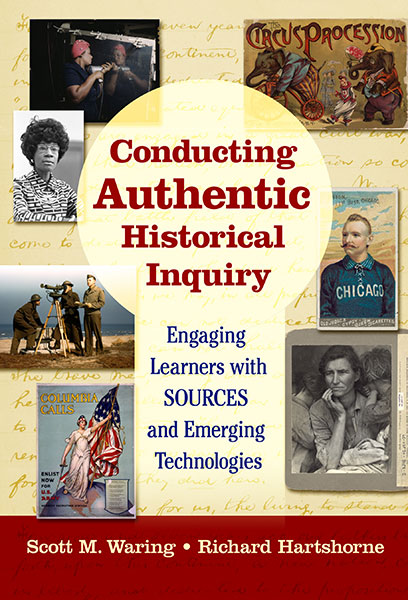Professors: Request an Exam Copy
Print copies available for US orders only. For orders outside the US, see our international distributors.
Scott M. Waring, Richard Hartshorne
Publication Date: August 21, 2020
Pages: 208

Engaging students with primary sources that foster inquiry, critical thinking, and deductive reasoning skills, all of which are vitally important to success in school and beyond. Simply inserting primary sources into the classroom is not enough. This resource uses the best of emerging Internet applications (Web 2.0) to capture the interest of today’s students who have grown up using diverse technologies and multiple applications such as podcasts, social networks, social bookmarks, digital curation, and blogs. Readers will learn about the SOURCES Framework, an innovative approach for scaffolding inquiry-rich social studies instructional practices. Filled with multiple classroom-ready examples that seamlessly integrate Web 2.0 applications, the authors provide readers with the tools and confidence to create instructional opportunities to engage learners in authentic historical inquiry. The goal is to give students the skills and knowledge necessary to think critically, engage with sources, and create authentic, evidence-based narratives. Conducting Authentic Historical Inquiry will be of interest to instructional technology coordinators and university faculty teaching courses in instructional technology and design.
Book Features:
Scott M. Waring is a professor and the program coordinator for the Social Science Education Program at the University of Central Florida. Richard Hartshorne is a professor and chair of the Learning Sciences and Educational Research department at the University of Central Florida.
“Exceptionally well written, organized and presented, Conducting Authentic Historical Inquiry: Engaging Learners with SOURCES and Emerging Technologies is an ideal curriculum textbook and unreservedly recommended for school district, college, and university library History Education collections and supplemental curriculum studies lists.”
—Midwest Book Review
Contents (Tentative)
Preface
PART I: UNDERSTANDING THE SOURCES FRAMEWORK
Chapter 1: The Sources Framework: An Introducion
Steps to Preparing Students to Think Historically and Utilize Primary Sources
Critical Examination of Sources
Evaluation of Sources
Primary Source Sets
The SOURCES Framework for Teaching With Primary Sources
Chapter 2: What Would Historians Write About Thomas Garber?: An Application of a SOURCES Lesson
Scrutinizing the Fundamental Source(s)
Organizing Thoughts
Understanding the Context
Reading Between the Lines
Corroborating and Refuting
Establishing a Plausible Narrative
Summarizing Final Thoughts
Conclusion
Chapter 3: Assessing General Washington’s Plan to Attack Princeton at the Beginning of 1777: An Application of the SOURCES Framework
Scrutinizing the Fundamental Source(s) and Organize Thoughts
Organizing Thoughts and Understanding the Context
Reading Between the Lines
Corroborating and Refute
Establishing a Plausible Narrative
Summarizing Final Thoughts
Conclusion
Chapter 4: Building Capacity for Student Agency: Using Baseball-Related Primary Sources and SOURCES Framework
Scrutinizing the Fundamental Source(s)
Organizing Thoughts
Understanding the Context
Reading Between the Lines
Corroborating and Refuting
Establishing a Plausible Narrative
Summarizing Final Thoughts
Conclusion
Chapter 5: What Motivated the Wright Brothers?: An Application of the SOURCES Framework
Scrutinizing the Fundamental Source(s)
Organizing Thoughts
Understanding the Context
Reading Between the Lines
Corroboratating and Refute
Establishing a Plausible Narrative
Summarizing Final Thoughts
Conclusion
PART II: ENGAGING LEARNERS WITH WEB 2.0 TOOLS AND EMERGING TECHNOLOGIES: A STEP-BY-STEP GUIDE WITH THE SOURCES FRAMEWORK
Chapter 6: Defining Web 2.0 and Other Emerging Technologies
What is Web 2.0?
Why Integrate Web 2.0?
Conclusion
Chapter 7: Using Multimedia-Based Discussion and Polling Tools to Facilitate Scrutinizing the Fundamental Source(s)
Pedagogical Strategies for Scrutinizing Fundamental Sources
Hooks and Identifying Fundamental Questions
Merging Pedagogical Strategies and Emerging Technologies for Scrutinizing Fundamental Sources
Engaging Learners with Multimedia-Based Discussion / Bulletin Board Tools
Polling and Survey Tools for Facilitating Engagement and Fundamental Questioning Inside and Outside of the Classroom
Conclusion
Chapter 8: Using Collection, Categorization, Storage, and Annotation Tools to Facilitate Organizing Thoughts
Pedagogical Strategies for Facilitating Organizing Thoughts
Merging Pedagogical Strategies and Emerging Technologies for Facilitating Organizing Thoughts
Conclusion
Chapter 9: Using Collaborative and Discussion Tools to Facilitate Understanding the Context
Facilitating Understanding the Context
Pedagogical Strategies for Facilitating Understanding the Context
Merging Pedagogical Strategies and Emerging Technologies for Facilitating Understanding the Context
Conclusion
Chapter 10: Reading Between the Lines and Corroborating and Refuting: Using Scaffolding Tools for Source Sets
Pedagogical Strategies for Facilitating Reading Between the Lines and Corroborating and Refuting
Merging Pedagogical Strategies and Emerging Technologies for Reading Between the Lines and Corroborating and Refuting
Conclusion
Chapter 11: Developing and Publishing Tools to Facilitate Establishing a Plausible Narrative
Pedagogical Strategies for Facilitating Establishing a Plausible Narrative
Merging Pedagogical Strategies and Emerging Technologies for Establishing a Plausible Narrative
Conclusion
Chapter 12: Creating A Digital Portfolio to Facilitate Summarizing Final Thoughts
Pedagogical Strategies for Facilitating Summarizing Final Thoughts
Merging Pedagogical Strategies and Emerging Technologies for Summarizing Final Thoughts
Conclusion
Appendix: Additional Resources and Considerations
Implementing the SOURCES Framework: Additional Resources
Primary Sources and Copyright
Primary Source Repositories and Resources
SOURCES Framework for Teaching with Primary and Secondary Sources
The Future, Possibilities, Potential Roadblocks, and Making the Most of the Historical Inquiry Process
References
Professors: Request an Exam Copy
Print copies available for US orders only. For orders outside the US, see our international distributors.